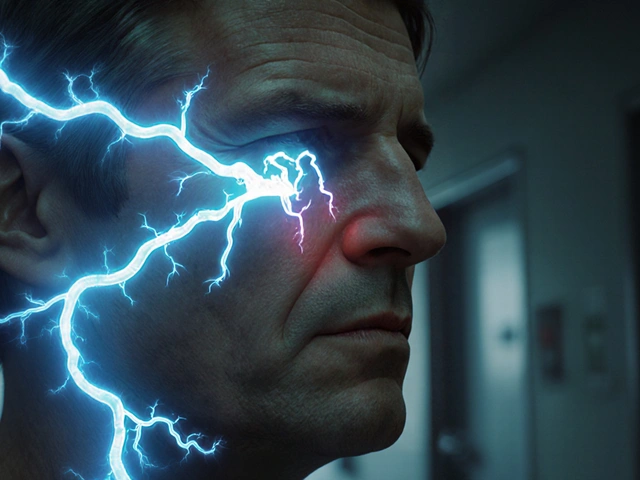
Feeling worn down by insomnia or fighting off the dark cloud of depression? Endep, a name you’ve probably heard tossed around by doctors and pharmacists, isn’t just another pill. It’s a decades-old antidepressant that’s quietly stuck around while newer meds stole the spotlight. People have found it surprisingly handy not only for depression, but also for chronic pain, anxiety, and sleep problems. Yet, beneath its mild-sounding reputation, Endep packs a punch—and it’s not for everyone. If you’re about to start it, or you’re just curious how it might help or mess with you, keep reading. There are things you’ll want to know before popping that first tablet.
What is Endep and Why Do Doctors Prescribe It?
Endep is the brand name for amitriptyline, an old-school antidepressant from the tricyclic antidepressant (TCA) family. It first landed in the medical world back in the early 1960s, which can make it sound outdated compared to the flashy antidepressants you see in TV ads—think Prozac or Zoloft. But here’s the twist: Endep is still on pharmacy shelves for a reason. Doctors prescribe it for major depressive disorder, but the list doesn’t stop there. Chronic pain syndromes, migraines, fibromyalgia, IBS, and even insomnia sometimes make the cut on a prescription pad. It’s this versatility that keeps it in the game long after many older drugs faded out.
When it comes to depression, Endep isn’t used as often as newer medications with fewer side effects, but if you’ve tried SSRI or SNRI meds and they didn’t work, your doctor might circle back to Endep. Sometimes, it pops up as a first choice for certain pain problems, especially neuropathic pain or migraine prevention, both in adults and kids. It tweaks chemicals in your brain—mainly serotonin and norepinephrine—that affect mood and pain signals. Science still can’t explain everything it does, but the bottom line is: Endep works for certain people when many other meds fail.
Now, if you’re scanning for advice, here’s an insider tip: doctors often start Endep at a much lower dose than the “regular” antidepressant range if it’s being used for pain or sleep. You might see tiny 10 mg doses at first, way less than you’d ever take for depression. Why so low? To dodge the notoriously rough start-up side effects.
What about the numbers? In Australia, Endep sits on the PBS (Pharmaceutical Benefits Scheme) list of subsidised meds. Stats from the last years show over 500,000 prescriptions a year—a lot for a "retired" antidepressant. And it’s listed as an essential medicine by the World Health Organization thanks to its effectiveness and low cost.
Understanding How Endep Works and What it Really Does
Ever wonder how a tiny pill like Endep can shift your entire mental and physical state? Here’s the nitty gritty: Endep changes how nerve signals move around inside your brain and, oddly, through the rest of your body, too. The magic happens mainly by blocking the re-uptake (recycling) of serotonin and norepinephrine, two chemicals your body uses to regulate mood, sensation, and even gut function. By keeping just a little more of those brain chemicals floating around, Endep helps stabilize mood and turn down “pain volume” in your nerves.
But unlike many new medications that laser in on one target, Endep’s shotgun approach tags multiple brain pathways. It messes with histamine, too—which helps explain why people often get drowsy on it. It also blocks acetylcholine, leading to those dry mouth and blurry vision side effects you’ll read about in a few paragraphs. No single effect totally explains all of Endep’s powers, but the result is often real relief for people who lived with pain, trouble sleeping, or deep-set anxiety for years.
Confused by different brand names? Don’t be. In some countries, Endep is sold as Elavil or Tryptanol, but the compound inside is the same. The main difference is in how it’s packaged and, sometimes, which doses are available.
| Condition | Typical Starting Dose | Common Target Dose |
|---|---|---|
| Depression | 25 mg/day | 75-150 mg/day |
| Chronic Pain | 10-25 mg/day | 25-75 mg/day |
| Sleep or Nerve Pain | 10 mg/night | 10-50 mg/night |
All this means that getting the dose right is a bit of an art. Start too high and you’ll feel like a zombie. Start too low and you might think it’s not working. If you’re using Endep, don’t tweak your dose without speaking to a doctor; changing things suddenly can land you in a world of trouble with side effects or withdrawal.
If you’re hunting for results, be patient. It’s not instant. For mood, most people won’t notice much for a week, and full effect can take up to four weeks. When using it for pain or migraines, results sometimes appear faster—sometimes in just a few days. Your doctor will weigh up benefits after about four to six weeks.

Side Effects, Risks, and Safety Tips
Here’s where most people get nervous: side effects. Endep isn’t famous for being kind at the start, especially if you jump in quickly or use higher doses. The big offenders show up mostly in the first week or two. Dry mouth tops the list. Up next: constipation, weight gain, blurred vision, dizziness, and feeling tired or groggy in the mornings. The grogginess is why doctors love using tiny nighttime doses for sleep problems. At higher doses or in older folks, Endep can sometimes cause confusion, memory slips, or a weird feeling like you’re unsteady on your feet—so it’s not usually recommended if you’re over 65 unless there are no good alternatives.
Worried about your heart? You should be, but only a little unless you already have a heart condition. Endep can slightly increase heart rate and may cause abnormal heart rhythms in rare cases, especially if you’re taking higher doses or mixing it with other meds. If you already have heart issues or you’re taking other drugs that affect your heart rhythm, be sure to mention this to your doctor. Sometimes a quick heart check (ECG) might be needed before starting or during treatment.
There are some real dangers to know. First, Endep is toxic at overdose levels—one reason it’s prescribed at low amounts and with care. Intentional or accidental overdoses can be deadly. If you have a history of self-harm, your doctor will absolutely want to know before offering this med. Second, never quit Endep suddenly. Stopping cold turkey can set off withdrawal symptoms: insomnia, irritability, sweating, and more. If you ever need to stop, do it slowly, working with your doctor bit by bit.
Wondering if Endep will conflict with your other meds? It can. Crazy as it sounds, some antihistamines, antibiotics, blood thinners, and even herbal supplements (like St. John’s Wort) can crank up side effects or make Endep less effective. Be honest with your healthcare team about every pill, vitamin, and tea you take—it can make a difference.
- If constipation is bugging you, drink extra water, add more fiber, and try gentle movement like walking daily.
- Dry mouth? Sipping water all day helps, and you can chew sugar-free gum.
- Feeling drowsy in the morning? Make sure you’re not taking other sedatives and ask your doctor about moving the dose earlier in the evening.
- Worried about weight? Keep an eye on nighttime snacking because Endep is notorious for stoking your late-night hunger.
- Don’t drive until you know how Endep hits you. Reactions vary, and grogginess at first is common.
On the bright side, a lot of these unwanted effects do settle down after the first month if you stick to the lowest dose that works. Your doctor will often keep tabs with an office visit a couple weeks after you start. Never hesitate to ask about odd symptoms—there are often little tricks or dose tweaks that can help.
Tips for Living Well With Endep and When to Seek Help
So you’re on Endep, or about to be, and you want life to keep rolling smoothly. The biggest lesson? Listen to your body and stay honest with your doctor. Rushed changes or silence about symptoms can torpedo your progress in a hurry. Most docs will start you slow, nudge up if needed, or even suggest backing down if morning grogginess, dizziness, or dry mouth get too much. Don’t be shy—report every weird thing you feel. Your experience shapes your treatment plan more than any textbook ever could.
If you’re finding value in Endep for pain or mood, look at your daily routine, too. Consistent sleep, regular meals, enough water, and some light movement all boost your odds of feeling better longer. You can keep a symptom diary, jotting down any changes when you tweak your dose or start new meds so your doctor sees the whole picture.
If you ever notice chest pain, severe dizziness, trouble urinating, or sudden mood changes (including feeling hopeless, agitated, or suicidal), don’t wait—seek immediate help. Those are rare but urgent signs that the drug isn’t the right fit or a dangerous interaction is happening. For most people, though, these emergencies never show up. Just having that game plan in the back of your mind lets you use Endep safely.
Want to stop Endep? Plan it carefully. Most doctors step down your dose over weeks—not days—to dodge withdrawal. If you miss a dose, take it as soon as you remember unless you’re close to your next one. Doubling up can lead to a cascade of side effects.
And finally, remember that even though Endep’s been around for sixty years, it’s not stuck in the past. It’s still being studied and prescribed for “off-label” things like sleep, PTSD, and even jaw pain (TMJ disorders). Some migraine clinics swear by it. What works for you might be different from your neighbor or even your sibling. Stick with what actually helps, stay curious, and talk through any worries with your care team. That way you get the benefits without risking the downsides.




18 Comments
Start low and go slow. 10mg at night changed my life for sleep and nerve pain. No zombie mode, just quiet relief.
I’ve been on this for 8 months for fibro pain. Drowsy at first, but now I sleep like a baby and my legs don’t scream anymore. Worth it.
Am I the only one who thinks prescribing a 60-year-old tricyclic with anticholinergic side effects is medical malpractice? SSRIs are cleaner, safer, and less likely to turn you into a dry-mouthed ghost.
Keith, you’re right that SSRIs are cleaner-but what if they don’t work? I tried five of them. Nothing. Then my doc tried 25mg of amitriptyline at night. Within three weeks, my chronic back pain dropped 70%. No magic bullet, but sometimes the old junk works when the shiny stuff fails. It’s not about being trendy-it’s about what keeps you alive.
Oh please. ‘Keeps you alive’? That’s dramatic. You’re talking about a drug that causes urinary retention, orthostatic hypotension, and QT prolongation. If your ‘lifeline’ requires an ECG before you take it, maybe you’re not ‘alive’-you’re just not dead yet.
While the pharmacokinetic profile of amitriptyline is indeed complex, its clinical utility in neuropathic pain management is supported by Level 1 evidence per Cochrane reviews. The risk-benefit ratio remains favorable in carefully selected patients, particularly when non-pharmacological interventions have failed.
I used to think this drug was a relic-until my mom, 72, started on 10mg for post-stroke neuropathy. No more crying at night from leg pain. She’s not ‘zombified.’ She’s gardening again. Sometimes the medicine that feels like a relic is just the one that remembers how to heal when modern ones forgot.
It’s not about being old. It’s about being right.
And yes, dry mouth sucks. Sip water. Chew gum. But don’t let fear of side effects blind you to relief that actually works.
I’ve been on this for two years. I gained 40 pounds. My tongue feels like sandpaper. I forget my own birthday. My husband left me because I was ‘emotionally unavailable’-which is code for ‘I was too sedated to care.’ I thought it was my depression. Turns out it was the amitriptyline. I tapered slowly. I’m better now. But I still wake up at 3am wondering if I made the right choice. I miss the numbness. I hate the clarity. I don’t know what I want anymore.
Don’t quit cold turkey. I did. Woke up sweating, shaking, crying for no reason. Took me 3 weeks to feel human again. Doc said it’s like withdrawing from a mild opiate. Don’t be dumb. Go slow.
my doc put me on 10mg for migraines and i thought it was a joke. but after 3 weeks i had half the headaches. also i sleep like a rock. i used to be up at 3am scrolling. now i just… sleep. its not perfect. dry mouth sucks. but i’ll take it. thanks for sharing this
Endep is the quiet hero no one talks about. The grandma of meds who still shows up when the new kids burn out. I’m not here to sell it-I’m here to say: if it helps you breathe again, don’t let the critics make you feel guilty for using it. Your healing doesn’t need to be trendy.
Bro… I tried this for insomnia and it made me hallucinate my cat talking to me in Mandarin 😅 I mean… it worked? But now I’m scared to take anything else. What’s next? LSD for anxiety?
For anyone on this: keep a journal. Note your sleep, mood, bowel movements, and energy. You’ll start seeing patterns. My doc adjusted my dose from 25 to 15mg after I showed her my notes. Best decision I made.
Why do people romanticize this drug like it’s some ancient wisdom? It’s a chemical sledgehammer. They call it ‘effective’ because they don’t know what real mental health care looks like. Therapy. Sleep hygiene. Light exposure. Nutrition. Not a 60-year-old poison disguised as a solution.
The FDA-approved indications for amitriptyline are limited to depression. All other uses are off-label. Prescribing it for migraines or IBS without disclosing this constitutes a lack of informed consent. This is not medical practice. It’s legal gray-area pharmacology.
While I acknowledge the clinical efficacy of amitriptyline in specific contexts, I must emphasize the necessity of pharmacogenetic testing prior to initiation, particularly for CYP2D6 and CYP2C19 polymorphisms, which significantly influence metabolic clearance and risk of toxicity. Without such screening, the administration of this agent constitutes a significant clinical risk.
So… you’re telling me the drug that makes you feel like a zombie, gives you a mouth full of cotton, and makes you gain weight is somehow ‘better’ than just… going to therapy? I’m not impressed. This is 1965 medicine in a 2025 world. We’ve got apps for sleep, meditation for anxiety, and doctors who actually listen. Why are we still using this?
If you’re taking Endep for insomnia, you’re not treating sleep-you’re sedating yourself into oblivion. Real sleep doesn’t require a chemical blackout. This is pharmaceutical pacification. Pathetic.